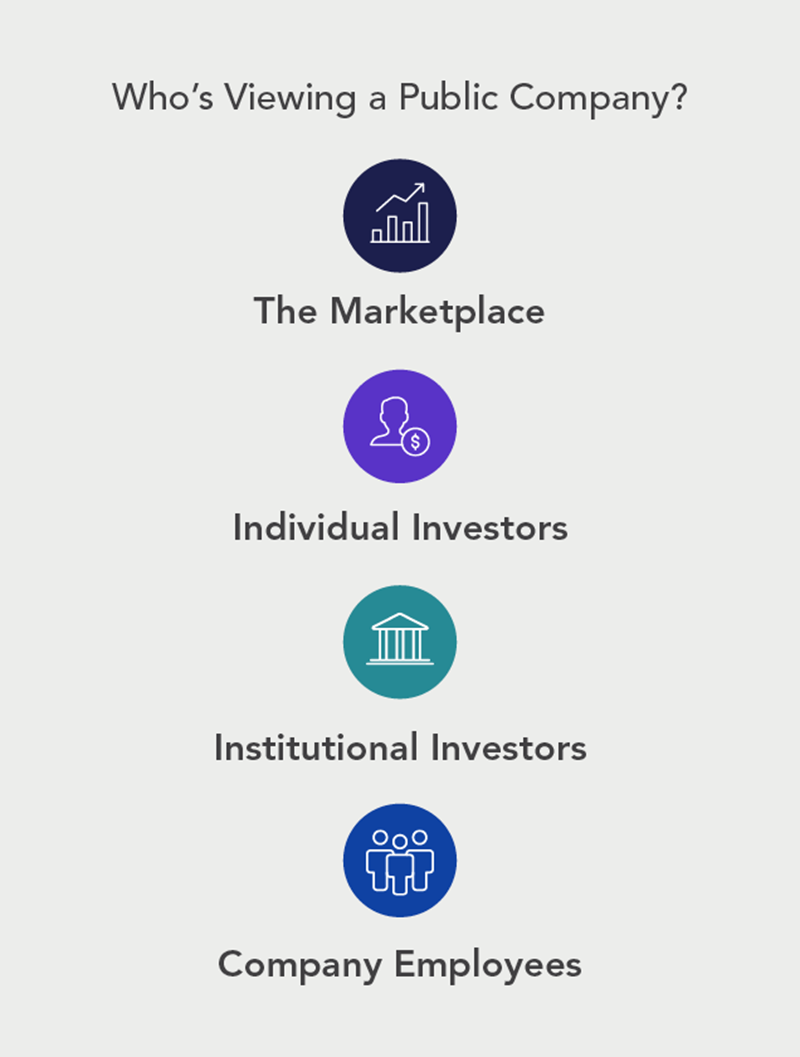The First Big Decision
What happens in the first year if a company monitors and understands how its shareholder audience is evolving from the IPO date forward – and what happens if it does not?
Some companies may not appreciate how dynamic the markets are and how critical shareholders are to future growth. Companies actually have much more power than they often realize. If they take the reins, they are in a better position to encourage new investors to buy and existing investors to maintain their position – and depending on circumstances, even encourage some to sell.
What happens in the first year if a company monitors and understands how its shareholder audience is evolving from the IPO date forward – and what happens if it does not? Some companies may not appreciate how dynamic the markets are and how critical shareholders are to future growth. Companies actually have much more power than they often realize. If they take the reins, they are in a better position to encourage new investors to buy and existing investors to maintain their position – and depending on circumstances, even encourage some to sell.
- One is through the natural course of business. Investors are attracted by what the company is doing. That’s the efficient market theory: build it and they will come.
- The second relies on ownership intelligence to enable the company to actively manage its development as a business. Monitoring who’s buying and selling quantifies why investors are acting as they are. Are they buying because they support the company’s mission and vision, or are other market forces in play? Who’s in it for short-term gain, and who’s committed to the company?
The second reason is the gateway to maintaining control of the company, understanding the potential implications of strategic directions for expansion into new products and services or markets, and positioning it in the marketplace to help drive maximum profitability. Now let’s examine how this process works and why being intelligent about your ownership is a critical step for a newly public company.

The Emergence Of Shareholders
From a public ownership point of view, a company is effectively created as of its first IPO date. Creating a public company also means creating a broader shareholder base than as a private company, and marketplace interest. One of the most significant transformations going from private to public involves the rapid-fire alteration of the company’s shareholder audience across multiple trajectories. Among the shareholder related events put in motion when a company goes public are:
- The market sees the company for the first time.
- Individual investors begin making the decision whether or not to invest.
- Institutional investors start making the same decision.
- Employees are deciding whether to invest further, or exercise their stock options when the window becomes available.
Proactive Shareholder Engagement
All of these moving parts will define what the company’s shareholder audience will look like by the time of the first annual general meeting. A company can watch the process passively and from a distance – which will result in a certain type of outcome when the dust settles. Relying on an efficient market, the company is letting the marketplace decide its fate. Or a company can actively and even proactively observe and manage shareholder decision making, and put in place the strategies to help achieve the most positive outcome for the future of the company and in support of its own business goals and objectives. It’s a question that hardly needs asking. The optimal approach is to take the reins immediately and implement a proactive shareholder engagement strategy. That leads to the next decision point. The company can go it alone, or it can choose to hire a guide. If the latter, who can help the company manage its future? What type of advisor, information and strategic advice are needed?
Having A Public Audience
The learning curve is steep. A host of people were interested in getting the company into its new, public ownership form. Many have a vested interest in that transaction. But once the process is finished, the company is essentially alone without help or support when faced with a new set of critical questions, such as:
- What does the new public audience look like?
- What should it look like?
- How does it compare to the company’s peers?
Getting Ready For Prime Time
A specific example with details, from both the company viewpoint and how EQ helps, will illustrate how the company can approach the situation and what can be gained from engaging the right type of advisor.
As it goes IPO, the company will have little or no idea who their investors are. We do, though – for example, the composition of types of institutional investors (e.g., percentage of hedge funds). We also know the targets that might help best shape the company’s future and provide it with the greatest degree of flexibility to determine its own path.
Here’s how we begin. We start by putting in place three key metrics for the ownership intelligence process. These serve to both structure a clear view of events unfolding, and navigate to the overall ownership profile desired for target percentage of:
Tracking Starts Immediately
From the time of inception, we load the company’s allocation list into our Issuer Central platform to make visible what’s in street name and also what’s remains in registered name. We track activity and ownership immediately using the allocation list. This reveals all the investors who were there before the company listed and had shares in registered name.
We begin to perform this service directly after the pricing occurs. We monitor the initial pricing and shareholder activity. This is a decisive period for tracking ownership, as many outcomes can ensue from it. Critical to this is uploading ownership data ahead of the first filing.
Creating A Balanced Ownership
The new company will also need ownership intelligence in order to help it balance its shareholders between long-only institutional investors (“owners”) like pension funds who will stay the course, and fast-money investors (“traders”) like hedge funds whose value is to help create liquidity.
Institutional investors want to own the company because they like its story and as an owner, want to be part of it. Traders want to date, not marry. To thrive, the company will ultimately need a healthy range of ownership distribution including both owners and traders. And generally the company will seek to increase long-only institutional ownership after a given amount of time.
Achieving a balanced ownership for the proper level of liquidity involves a mix of ownership types. Traders are important in shareholder composition, because they provide the liquidity that will attract more owners, whose long-term position makes for better-quality, committed ownership that wants to see the company grow. From an investment perspective, an owner must ensure that when they take a significant position in a company, sufficient liquidity exists if they need to make changes to their investment. The value of liquidity to them is knowing enough volume exists that they can sell quickly without significant damage to the stock price or their own investment.
Shaping The Future
We’ve examined the two alternatives: The reasons why a company should take control of ownership intelligence; and some of the risks that can come into play when it doesn’t.
So much changes for a new IPO between the date of listing and the first annual general meeting. Everyone who was there exits once the IPO is complete. Strategic partners like the bankers are nowhere to be found. All of a sudden the company faces new needs and everyone who helped throughout the entire process has disappeared – at the precise moment they are felt to be most needed.
At this critical juncture that will determine the future of the company, it’s important to have expert guidance and easy-to-use tools to monitor transactional information. For that, the company should be able to lean on its transfer agent and ownership intelligence team. They alone can see all three windows of what’s coming and going, among institutional and individual investors and the marketplace. And they are the only ones who are beholden solely to the newly public company.
EQ Ownership Intelligence – Consultative And Online
We know what will happen post-IPO. EQ combination of deep expertise, rich data and platform performance offers a very concrete service that helps the company understand its new reality.
As the often inevitable fear and doubt of becoming a public company set in, you’ll need to feel you can rely on a company like EQ serving as transfer agent and ownership intelligence provider, whether consultative, Issuer Central, or both.
We will help qualify the investors – long only, growth oriented, etc. – and characterize the shareholder base for you, in order to enable you to track it and understand it over time. Importantly, we can also help you manage it to the outcomes you desire. As a newly public company:
- Start with Ownership Intelligence on Issuer Central, a self-service online portal with a full suite of shareholder data.
- Move up to Ownership Intelligence consultative services over time, or to help address specific situations such as shareholder activism.





